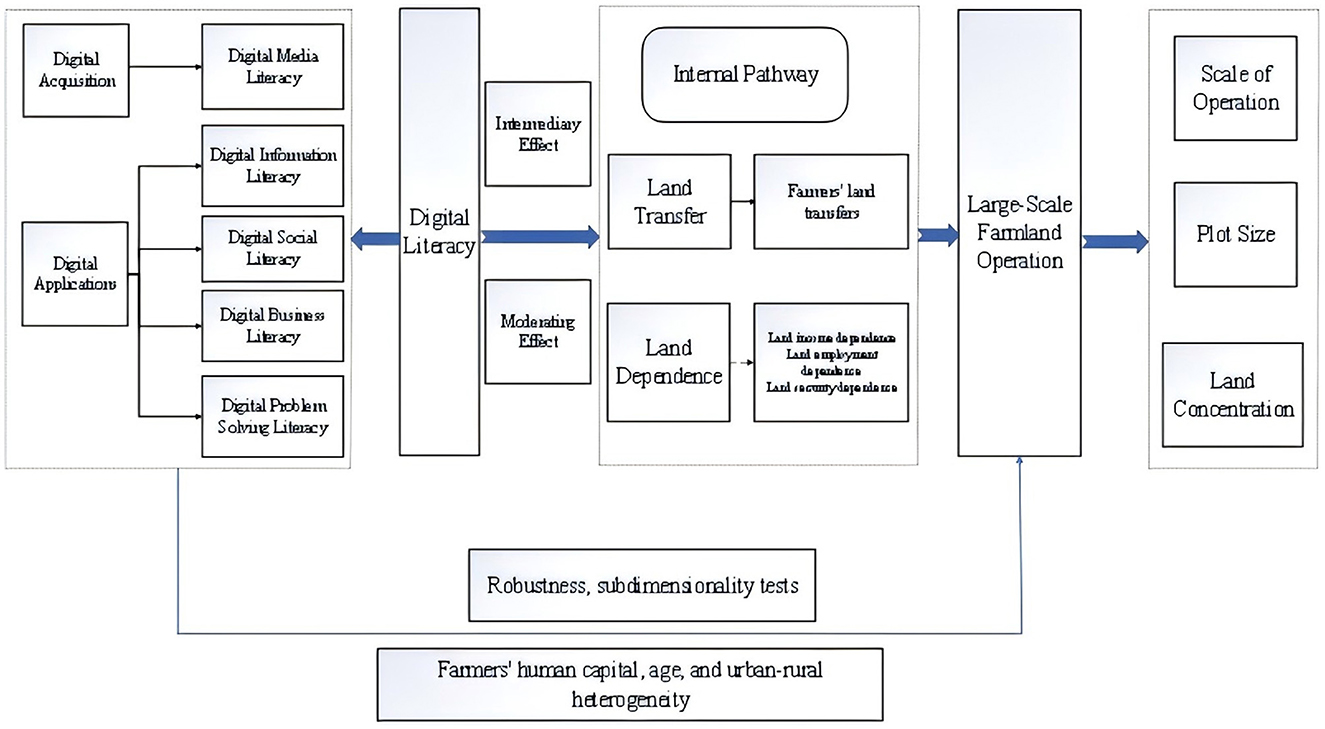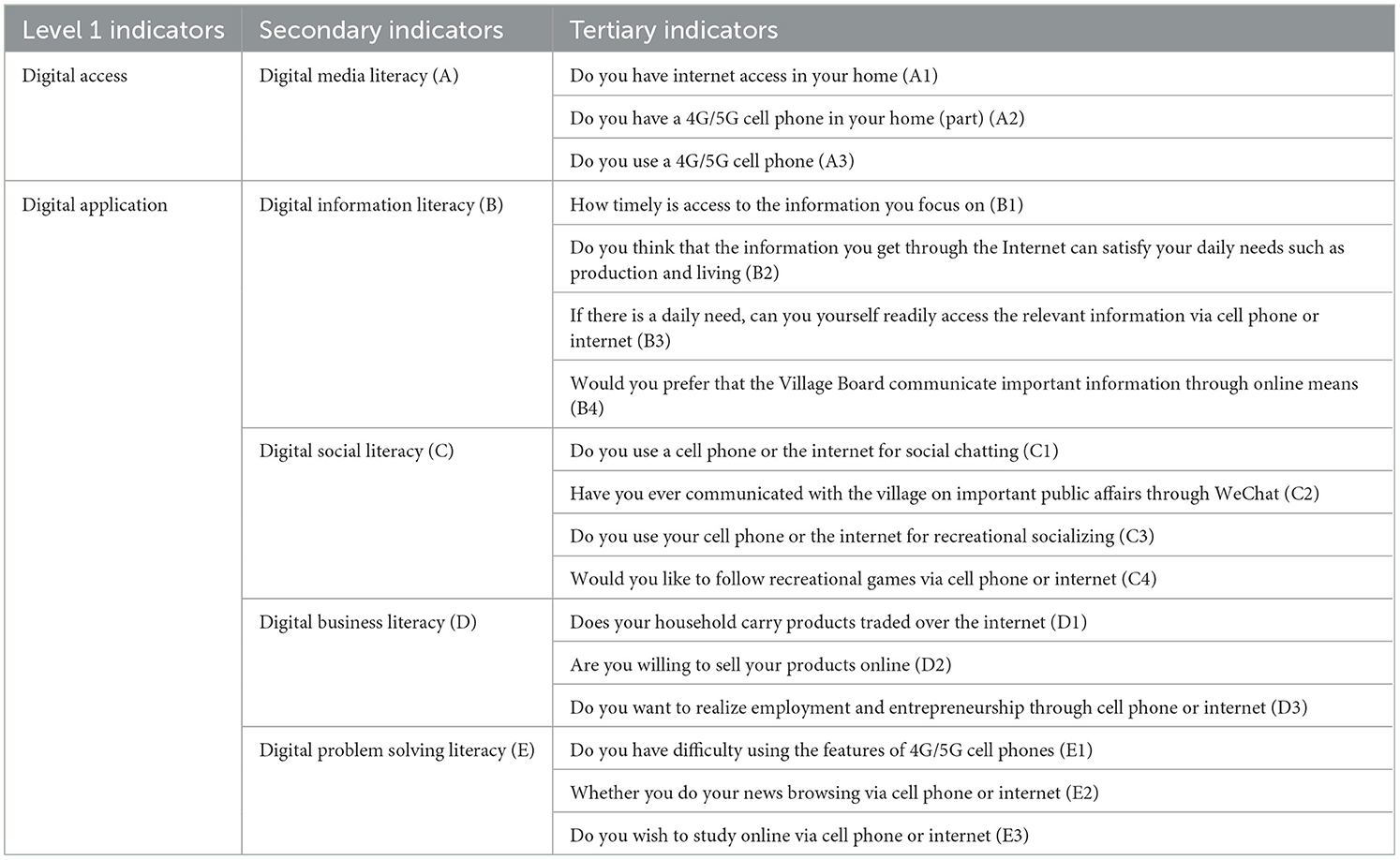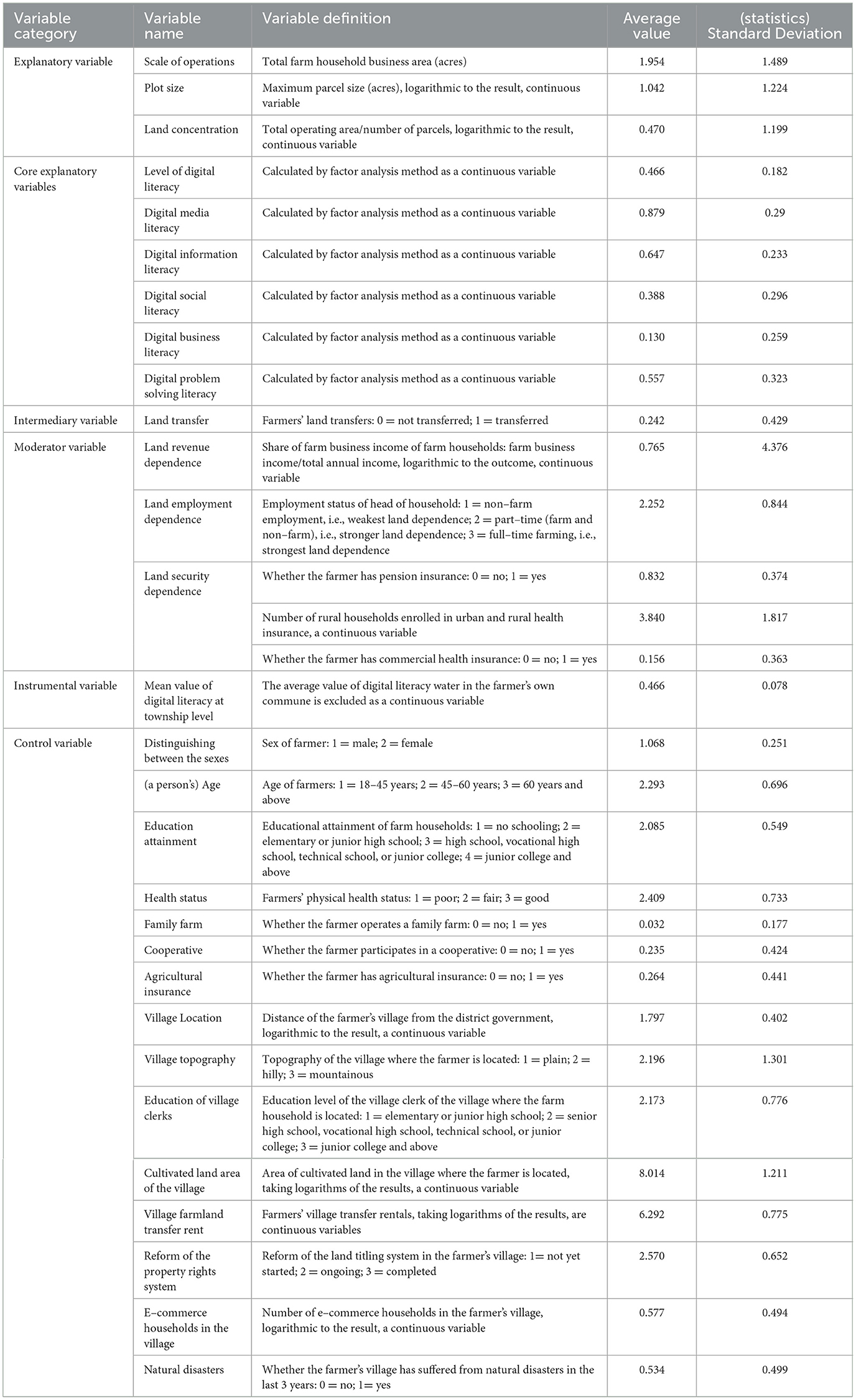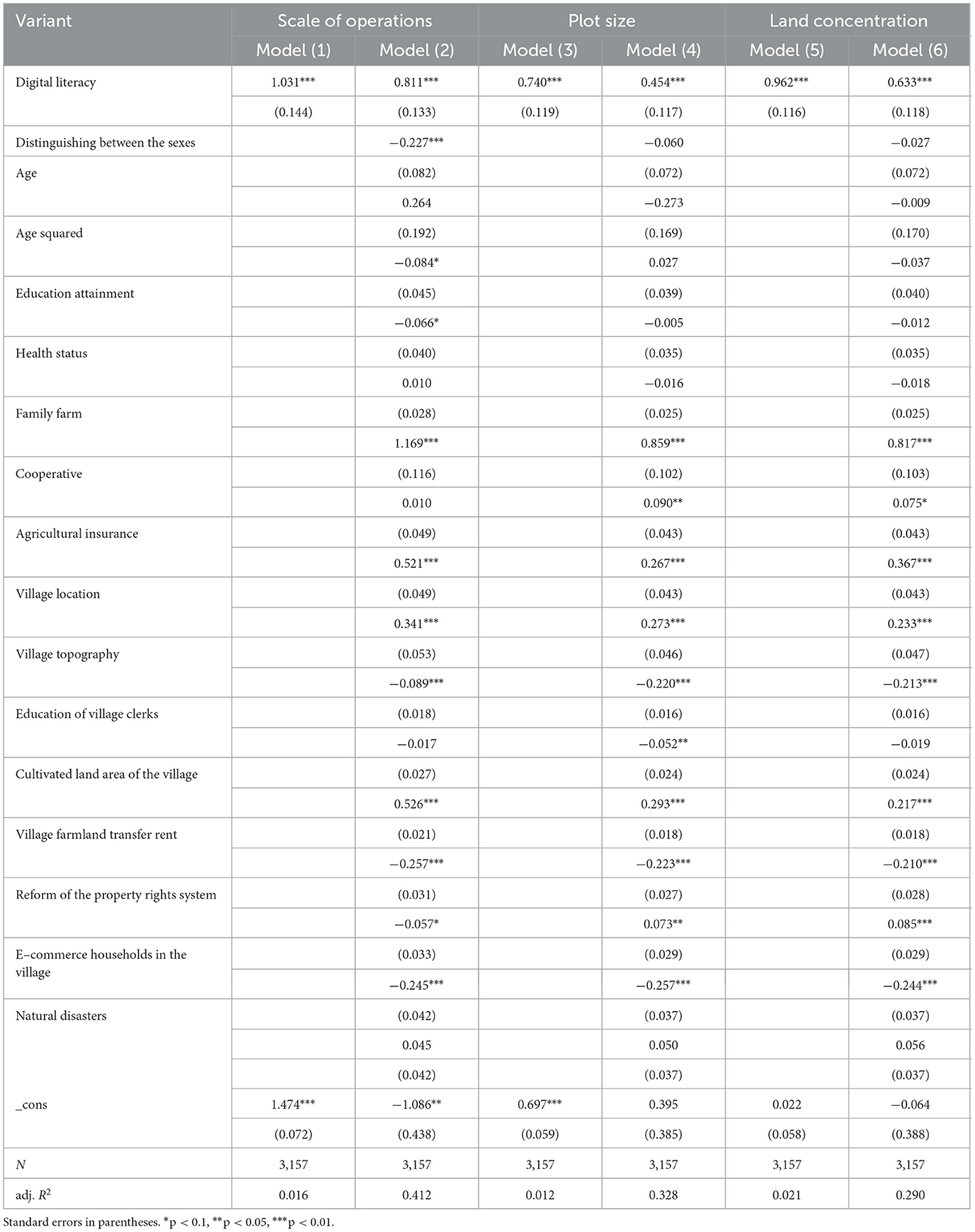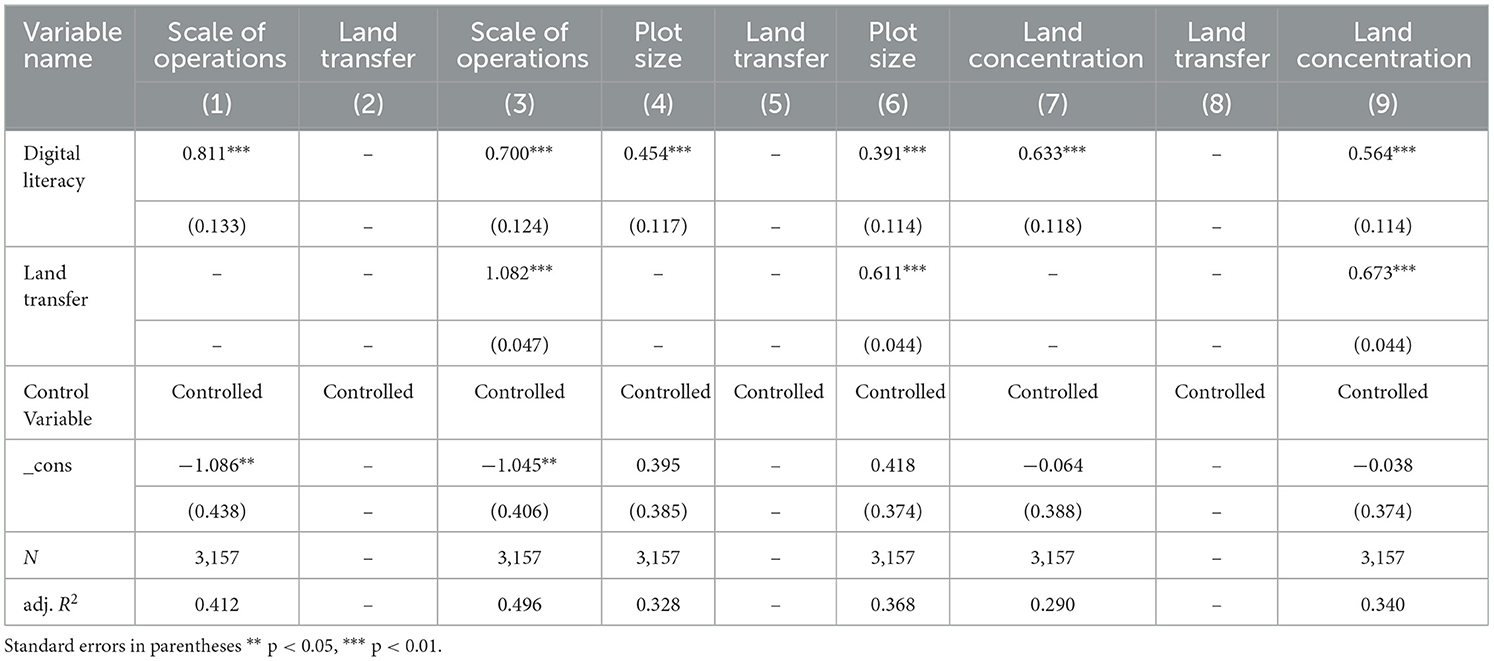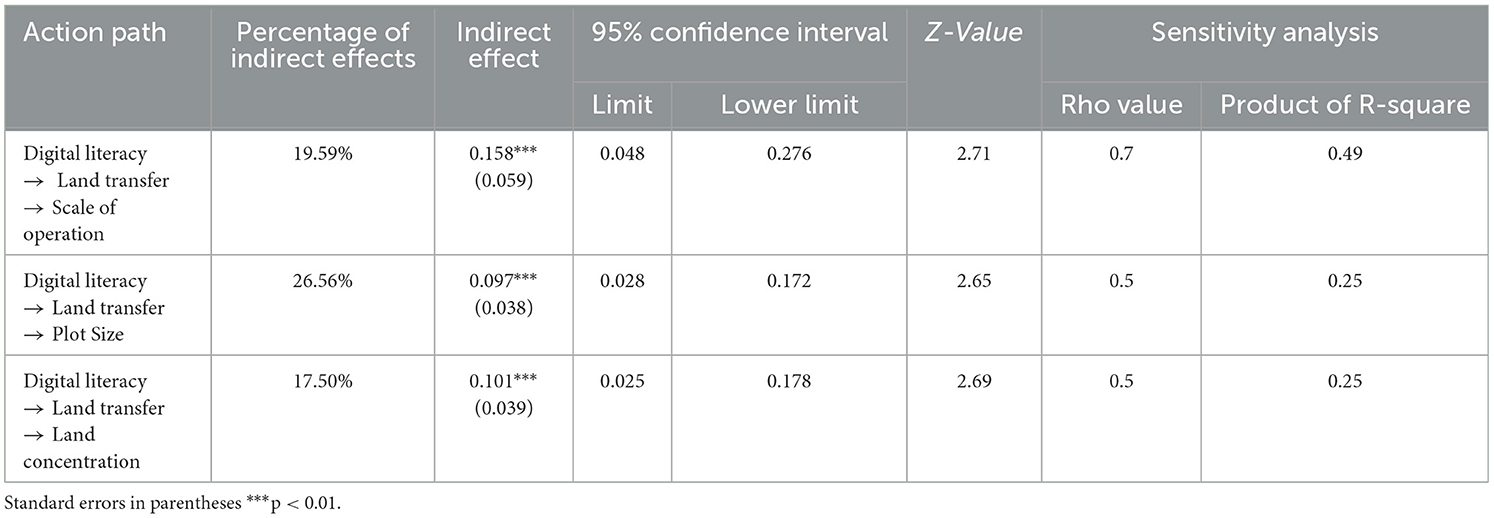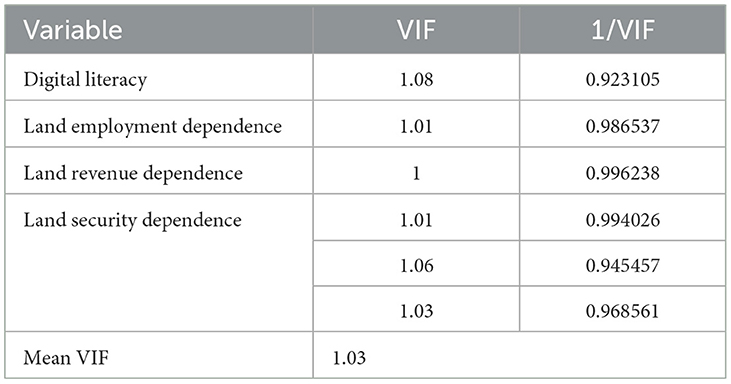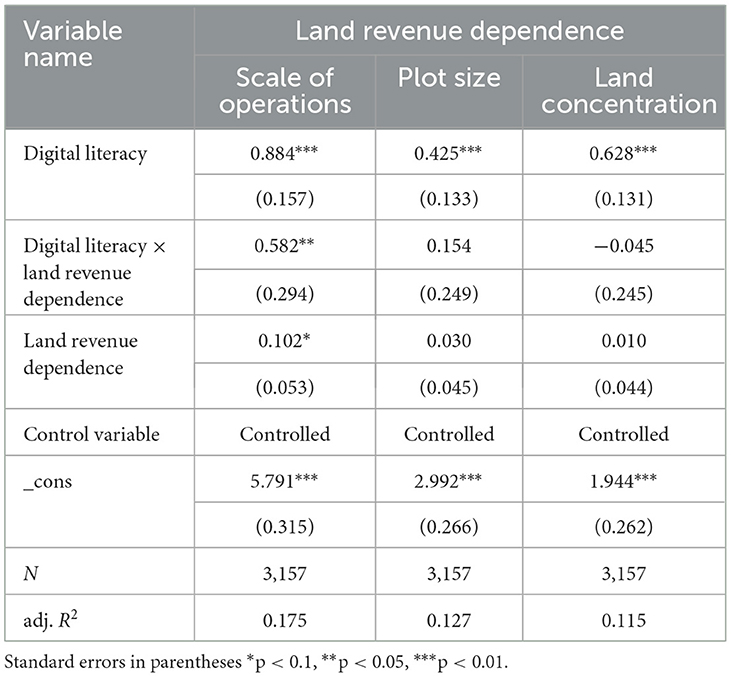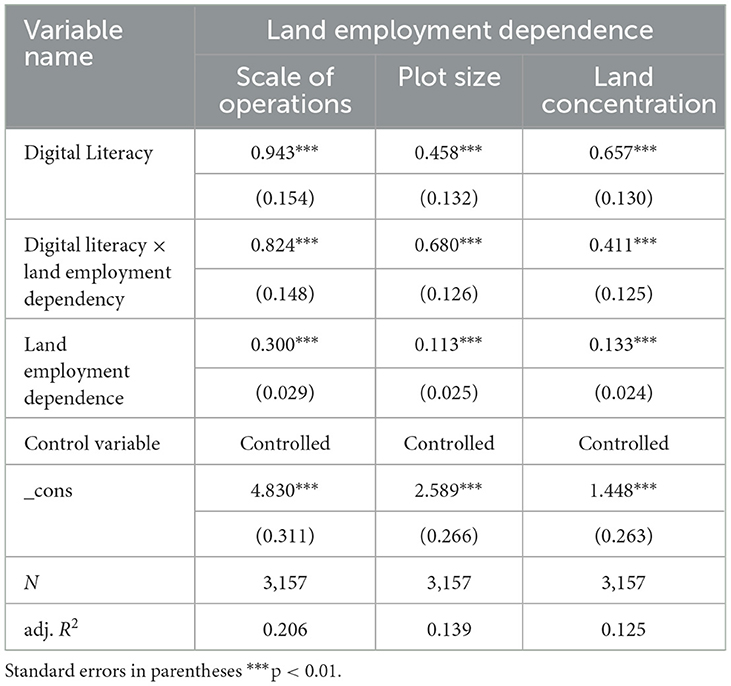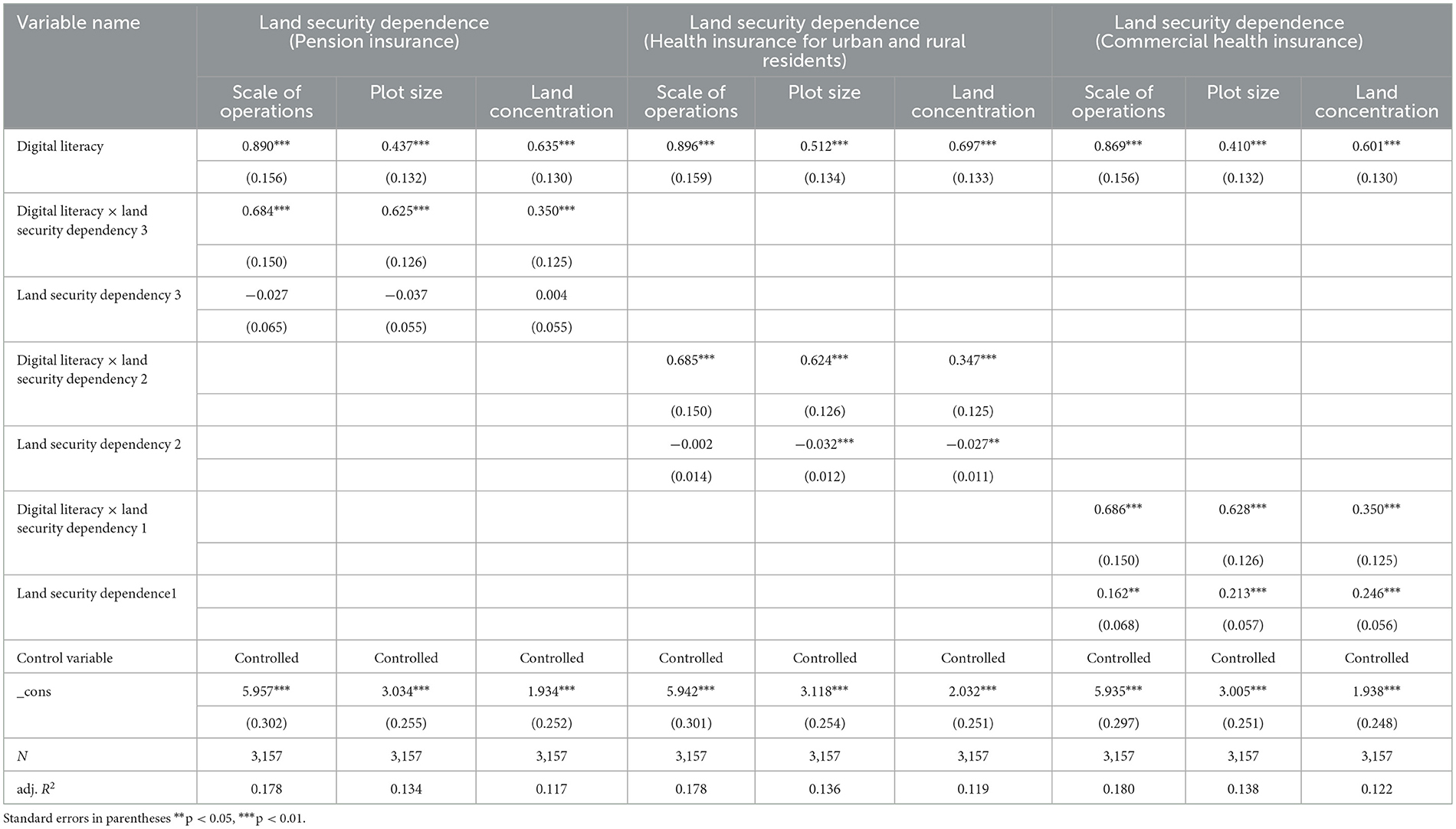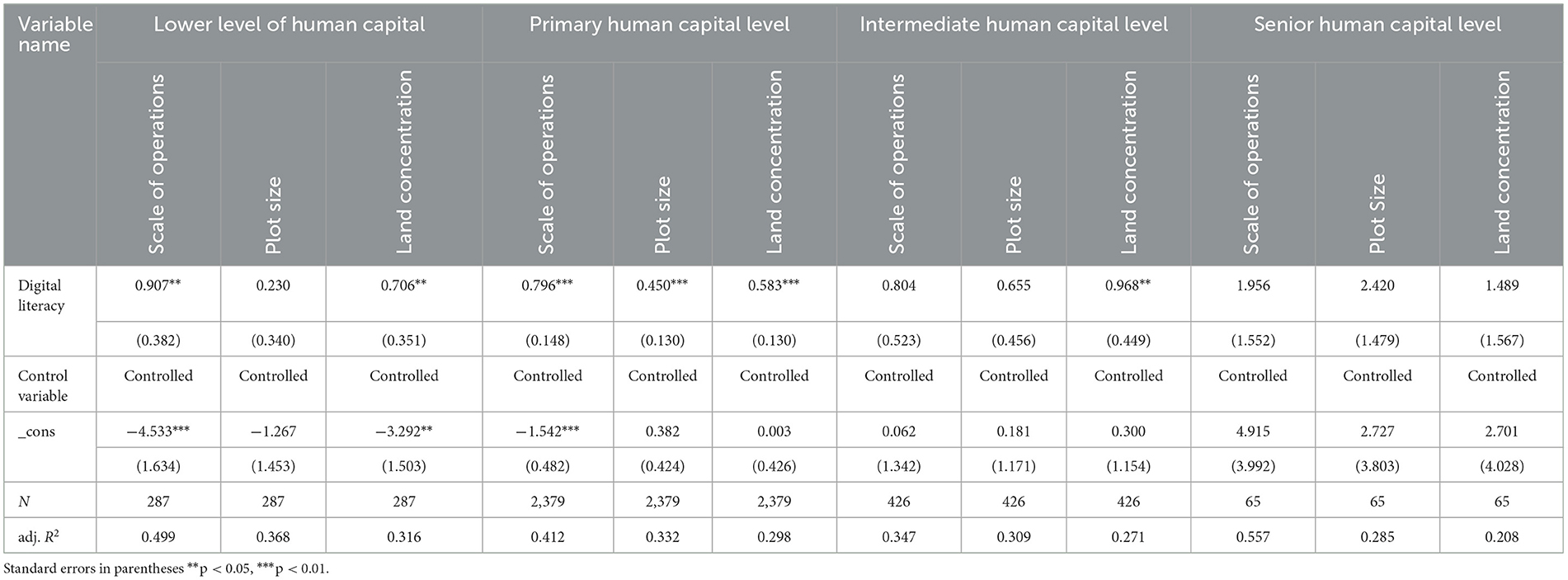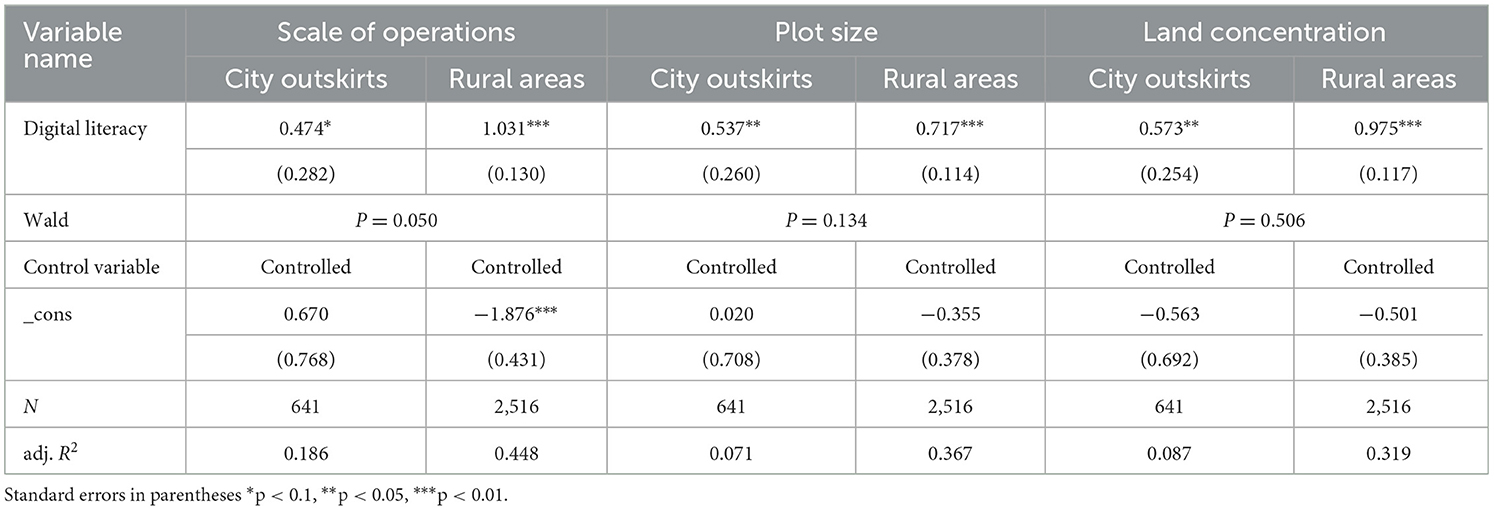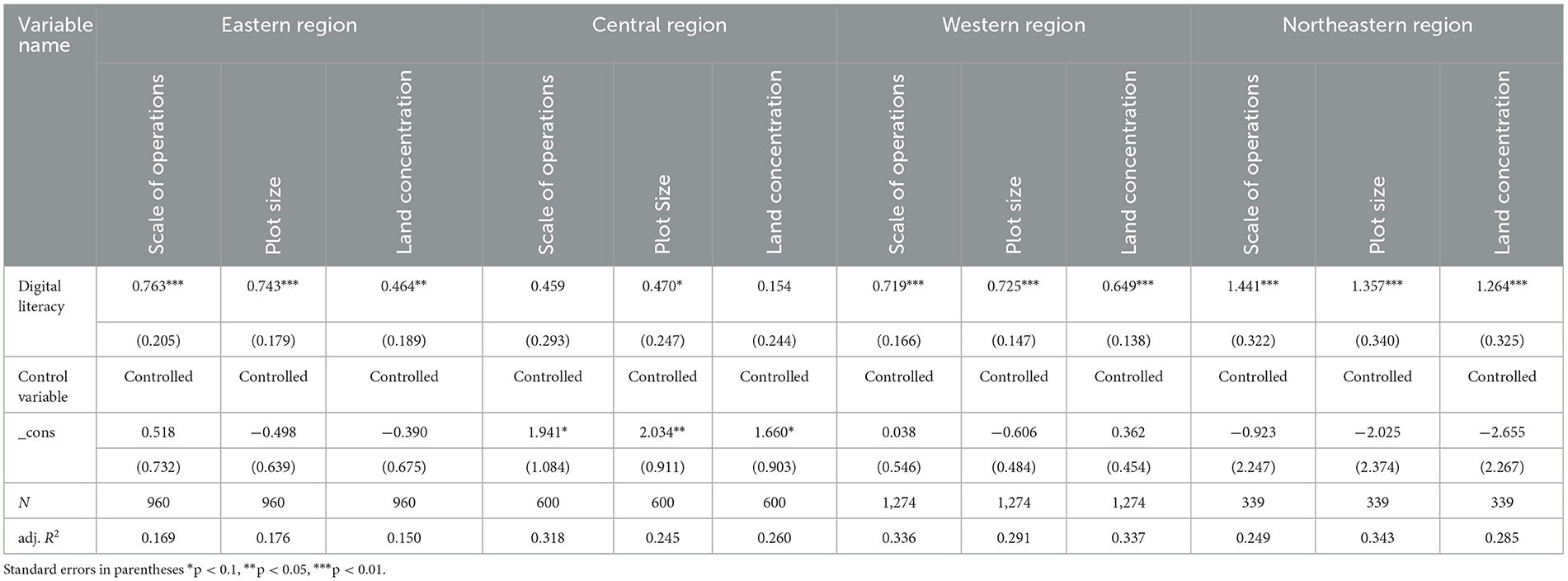- 1College of Economic and Management, Henan Agricultural University, Zhengzhou, China
- 2Nanchang Business School, Jiangxi Agricultural University, Jiujiang, China
- 3College of Economic Management, Jiangxi Agricultural University, Nanchang, China
Introduction: Agricultural scale operation serves as a crucial avenue for advancing the construction of agricultural modernization and fostering the development of a formidable agricultural nation. It is important to note that agricultural scale operation underscores not only the expansion of land acreage but also the contiguous and integrated management of land parcels.
Methods: This study utilizes data from the 2020 Chinese Academy of Social Sciences rural revitalization research to assess farmers' digital literacy levels through factor analysis and principal component analysis. After elucidating the underlying logic of how digital literacy influences the scale of agricultural land operations, we employ linear regression models, mediated moderation models, and other statistical tools to delve into the specific impacts of farmers' digital literacy on their farmland scaling behaviors.
Results: The findings reveal that: (1) Digital literacy exerts a positive effect on the scale of farmland management undertaken by farmers. Specifically, for every unit increase in farmers' digital literacy, there is an average corresponding increase of 0.811 units in the overall scale of farmland management, 0.454 units in plot size, and 0.633 units in land concentration, respectively. (2) Mechanism testing reveals that an enhancement in farmers' digital literacy facilitates farmland transfers, thereby promoting large-scale farmland operations. Additionally, farmers' land dependence amplifies the positive effect of digital literacy on such operations. (3) Sub-dimension analysis yields further insights: In the realm of digital access, improved digital media literacy encourages farmers to consolidate their land holdings, expand production scales, harness economies of scale, and ultimately boost agricultural production efficiency. Within the digital application dimension, heightened levels of digital business literacy and digital information literacy among farmers spur the expansion of their land operation scales and increase land concentration. Conversely, elevated digital social literacy and digital problem-solving literacy primarily drive the expansion of land operation scales but exert minimal influence on land concentration. (4) Heterogeneity analysis uncovers variations in the impact of farmers' digital literacy on farmland scale operation behavior across different human capital levels, age groups, and urban-rural contexts.
Discussion: Consequently, to foster farmland scale operations, it is imperative to: Promote the development of rural digital infrastructure to enhance farmers' digital accessibility. Strengthen the factor market system to facilitate efficient circulation of various factors. Increase support for farmer benefits and assistance programs to bolster their risk resilience. Intensify skills training for farmers to activate their intrinsic motivations as primary actors in this process.
1 Introduction
Moderate-scale agricultural operations predominantly entail the scaling of land management, which encompasses the aggregation of land resources amidst the ongoing rural–to–urban labor migration, capital constraints in agriculture, and suboptimal technological advancements. This approach underscores horizontal specialization and the division of agricultural production labor within a given region, exemplified by the contiguous and concentrated planting of crops in designated areas. The global landscape of large–scale farm development is heterogeneous, owing to the disparate resource endowments, economic circumstances, and socio–cultural contexts of individual countries. As a prominent global agricultural leader, the United States exemplifies large–scale farm development through a high level of specialization and mechanization, facilitated by its extensive arable land resources, cutting–edge agricultural science and technology, and robust policy framework (Sumner, 2014; Key, 2019). In Asia, South Korea and Japan have adopted distinct strategies for agricultural scale management. South Korea facilitates extensive agricultural land management by means of policy legislation, resulting in a scenario where private management and leasehold management coexist (Kim and Kamiya, 1992). Conversely, Japan has maintained small–scale land management while achieving a high degree of modernization, including mechanization, informatization, and branding, through policy guidance and industrial adjustment (Kawagoe, 1999). The Association of Southeast Asian Nations (ASEAN) fosters the growth of comprehensive agricultural enterprises and the development of local production by augmenting investments in agricultural science and technology (ASEAN Secretariat, 2015; Rigg et al., 2016).
In contrast, China's agricultural landscape is characterized by a large number of small farmers. The core of China's land system revolves around the protection of arable land, food security, and farmers' livelihoods (Gao, 2019). Consequently, the Chinese government has actively explored the development of appropriately scaled agriculture, bridging the gap between small farmers and modern agriculture. The annual “Central Document No. 1” has consistently emphasized the importance of moderate–scale agricultural operations, addressing the question of “who will farm the land,” and affirming that agricultural modernization should uphold the foundational role of small farmers, prioritize the cultivation of new agricultural management entities, and strengthen the socialized service system.
However, given China's unique agricultural circumstances, the pursuit of large–scale agricultural land management encounters numerous constraints. Firstly, institutional factors play a pivotal role. While land system reforms at the national level have partially clarified agricultural land property rights, policy shifts or land adjustments often result in agricultural operations being built on an “unstable foundation,” leading to sustainability challenges (Tang et al., 2022). Secondly, resource endowment poses significant hurdles. Achieving high efficiency in agricultural production necessitates the optimal integration of land, labor, capital, and technology. Nonetheless, farmers as individual producers and managers confront escalating land rents (Liu and Kong, 2017), heightened financing costs, depressed food prices, reduced labor productivity (Du and Xiao, 2019), and an inadequate rural credit system. Furthermore, the agricultural labor force is increasingly characterized by aging, feminization, and diminished capacity, which contributes to low literacy levels among farm households, limited knowledge acquisition and skill enhancement, and delayed access to information (Xie, 2002). Thirdly, social factors complicate the decision–making process for farmers considering large–scale agricultural land management. These include a deep–seated “love for the land” complex, significant land dependence, limited awareness of agricultural land transfer options, uncertainties related to natural, and market risks (Wu et al., 2021), constraints in terms of agricultural timing, machinery, and technology (Xu, 2023), as well as livelihood strategy choices and income expectations (Shi et al., 2019).
The majority of research has centered on examining the relationship between farm size and land productivity, with a contingent of scholars subscribing to the theory of “inverse productivity” (Sen, 1962; Vollrath, 2007; Deininger et al., 2018; Julien et al., 2019). They attribute this phenomenon to various factors, including disparities in land quality (Lamb, 2003), measurement inaccuracies (Carletto et al., 2013), market inefficiencies (Barrett et al., 2010), inadequate risk management strategies (Sheng et al., 2015), and the misallocation of factorial resources (Adamopoulos et al., 2022), among others. Conversely, another cohort of researchers posits that the acceleration of urbanization and industrialization, coupled with rapid advancements in agricultural technology, machinery, and equipment, as well as the proliferation of non–farm employment opportunities, has led to the continuous migration of surplus agricultural labor to non–farm sectors. Consequently, the initial productivity advantage of small farms diminishes over time, revealing a “U–shaped relationship” (Rada and Fuglie, 2019; Sheng et al., 2019) or even a “positive relationship” (Wang et al., 2015; Key, 2019) between farm size and land productivity, ultimately culminating in the realization of economies of scale. These scholars primarily justify their stance through the lenses of mechanization and hired labor utilization. Furthermore, the existing literature predominantly employs land scale, specifically the area of land operated, as a metric for assessing agricultural operation scale (Liu and Zeng, 2004; Wang et al., 2012). This approach, however, overlooks the significant issue of land fragmentation prevalent in developing countries. It is crucial to recognize that an increase in operational scale does not necessarily equate to an enlargement of plot size and fails to provide a scientific explanation for the agricultural scale operations characterized by land concentration, contiguity, and specialization (Lv et al., 2024). In the context of China's current pursuit of high–quality agricultural development, disregarding the size of individual farmers' plots while solely focusing on the scale of operations, or conversely, neglecting the operational scale while only examining plot size, can lead to cognitive biases in understanding the scale of agricultural land management (Xu et al., 2024). Therefore, it is imperative to integrate both dimensions within the same research framework. Additionally, numerous scholars, both domestically and internationally, have delved into the practical pathways and implementation effects of agricultural scale operations (Yang et al., 2024), highlighting their potential to enhance food production, increase farmers' incomes, promote green agricultural development, and reduce carbon emissions. These contributions are undeniably pivotal for advancing agricultural and rural modernization, implementing the big food concept, and safeguarding the environment. Nonetheless, there remains a notable dearth of analysis exploring the deeper underlying factors influencing the scale of agricultural operations.
Simultaneously, amidst the swift progression of the information technology revolution, digital components have permeated every facet of societal life. Notably, digital technology is increasingly integrating into agricultural production and rural governance, endowing large–scale agricultural operations with a novel digital dimension, and the trend toward digitization in China's agricultural and rural sectors has become increasingly pronounced (Yang et al., 2024). According to the 52nd Statistical Report on Internet Development in China, by June 2023, administrative villages in rural areas had achieved “village broadband” connectivity, with an Internet penetration rate of 60.5%. The rural Internet user base has swelled to 300 million, and the 4G network infrastructure boasts a coverage rate as high as 98%1 Although the digital access divide is gradually diminishing, the digital literacy of rural households lags significantly behind the pace of digital economic advancement. In this new phase of development, the primary contradiction in the rural digital divide has shifted from the “digital first divide”—the disparity in digital access—to the “digital second divide”—the disparity in digital application (Wang, 2024). Digital elements diverge from traditional ones in that farmers must possess a certain level of digital literacy to effectively utilize digital technology in agricultural production decision–making, thereby harnessing its crucial role in enhancing agricultural productivity and efficiency (He et al., 2024).
Consequently, within the context of digital economic development, an inquiry arises: is there an inherent connection between farmers' digital literacy and the scale of agricultural land operations? Can elevating farmers' digital literacy levels transcend the current constraints impeding large–scale farmland management? What underlying mechanisms are at play? Investigating these questions holds multifaceted practical significance for activating the endogenous drivers of large–scale farmland management, disrupting ingrained agricultural development paradigms, and propelling the modernization of China's agriculture and rural areas. Furthermore, such research may offer valuable insights for other countries and regions grappling with limited arable land and severe land fragmentation. This study centers on examining the influence of farmers' digital literacy on the extent of farmland management and its underlying mechanisms, while accounting for the mediating roles of land transfer and land dependence. Utilizing data from the 2020 China Rural Revitalization Survey (CRRS) conducted by the Institute of Rural Development at the Chinese Academy of Social Sciences, we undertake a micro–level validation.
2 Theoretical framework and research hypotheses
2.1 The internal logic of digital literacy as it affects the farmland scale operations
Martin and Grudziecki (2006) proposed a comprehensive modeling framework to elucidate the evolution of the digital competence hierarchy. This framework is structured into three distinct levels: digital Competence, which encompasses a range of skills, knowledge, attitudes, and awareness pertaining to digital technologies; digital usage, contingent upon an individual's level of digital competence or digital literacy; digital transformation, which involves knowledge creation and technological innovation. Within this framework, digital literacy serves as an indispensable bridge. As an emergent form of human capital, digital literacy possesses unique value that transcends traditional metrics of labor quality. It not only bridges the gaps between basic and advanced digital access and technology application, commonly referred to as the “primary” and “secondary” digital divides, but also possesses the capability to transcend geographic and temporal constraints. Even in the context of a relatively modest educational background, workers can more swiftly, accurately, and efficiently grasp crucial information related to agricultural production and management. This, in turn, enables them to seize opportunities in the digital era and facilitate the modernization and efficiency of agricultural production (Liu and Zhou, 2023; Wang, 2024; Ruan and Luo, 2024).
Firstly, digital literacy serves as a catalyst for farmers' knowledge acquisition and learning. By enhancing their digital competencies, farmers can independently explore new agricultural skills and knowledge through modern technological platforms. This process not only enriches their personal knowledge base but also facilitates the accumulation and appreciation of human capital, thereby amplifying the positive externalities associated with knowledge learning. The acquisition of digital literacy enables small–scale farmers to swiftly adopt and utilize digital devices, mastering digital skills rapidly and gaining a competitive edge in agricultural production. This first–mover advantage manifests as a “skill premium,” where digitally proficient farmers outperform their traditional counterparts (Liu and Wen, 2024). Such farmers, equipped with high levels of knowledge and skills, are better positioned to access agricultural insurance, subsidies, socialized services, and technologies, applying them effectively to mitigate information asymmetry in agricultural production and enhance the market competitiveness of their products (Courtois, 2015).
Secondly, digital literacy significantly enhances farmers' information acquisition capabilities. The Internet transcends spatial and temporal constraints, broadening the avenues for farmers to acquire new knowledge and lowering the barriers to information access. Farmers with adequate digital literacy can adeptly navigate social platforms like Jitterbug, Shutterbug, Weibo, and WeChat to precisely search for information pertinent to agricultural production, non–farm employment, and entrepreneurial ventures, fostering self–service (Hua and Pan, 2024). Improved digital literacy also augments farmers' ability to capture financial capital information, encouraging the widespread use of digital financial tools. It expands their access to diversified financial information channels while reducing the costs associated with searching for agricultural business information, information acquisition, and credit fund transactions, ultimately enhancing resource allocation efficiency. This, in turn, alleviates the credit constraints farmers face when scaling up production, lowers financing difficulties and costs, and stimulates their enthusiasm for agricultural production and management (Wen and Liu, 2023). Consequently, this positive feedback loop inclines farmers toward expanding the scale of their agricultural land management, promoting intensification, and large–scale production practices.
Thirdly, digital literacy expands the social networks of farm households. In traditional rural societies, social networks rooted in blood, kinship, and geography deeply influence farmers' production and management decisions. However, enhanced digital literacy empowers farmers to transcend these inherent network limitations, utilizing digital tools and platforms to reconfigure their social network relationships and broaden the scope of resource sharing. This, in turn, fosters innovation and upgrading in their production and management decisions (Du et al., 2024). Farmers with higher digital literacy levels can strategically leverage social network resources, extending their production and transaction reach, bolstering persuasive social support for their farmland scale management practices, and gaining timely access to policy trends, production services, and sales information throughout the agricultural production cycle. This enhances the overall efficiency of agricultural production (Ruan and Luo, 2024).
Furthermore, enhancing farmers' digital cognition in the refinement of agricultural business practices fosters their capacity for in–depth market information analysis and efficient utilization. This transformation has facilitated a more precise comprehension of the economic and social ramifications of land fragmentation, which not only amplifies cost burdens but also hinders the intensive utilization and optimal configuration of land resources (Liang, 2022). Consequently, farmers have increasingly recognized the significance of land consolidation strategies, such as “small field to large field” consolidation and “one family, one field” policies, as effective means to promote large–scale land management and mitigate the supplementary costs associated with fragmentation. The centralization of land parcels not only enables farmers to implement mechanized operations more seamlessly, thereby enhancing agricultural production efficiency, but also stimulates the widespread adoption of socialized services. This, in turn, reduces production costs per unit area, elevates food yield and quality, and subsequently bolsters farmers' resilience to market risks, ensuring the stability, and sustainability of agricultural production. Hence, by improving farmers' digital literacy, they are more inclined to adopt scientifically sound and rational land adjustment methods, thereby diminishing land fragmentation and fostering increases in grain yield and steady growth in farmers' incomes (Zhang et al., 2023). Building on this foundation, the present study posits the following hypotheses:
H1: the higher the level of digital literacy, the higher the likelihood that a farmer's farmland will be operated on a large scale.
H1a: the higher the level of digital literacy, the greater the likelihood that farmers will expand their farmland operations.
H1b: the higher the level of digital literacy, the greater the likelihood that farmers will expand the size of their farmland plots.
H1c: higher levels of digital literacy are associated with larger average plot sizes for farm households and contribute to improved land fragmentation.
2.2 Analysis of the intermediary impacts of land transfer
Digital literacy enables farmers to expand the scale of agricultural land management, increase land plot sizes, and ameliorate the issue of contracted land fragmentation, primarily through their land transfer activities. Initially, farmers with high digital literacy can swiftly access agricultural policy information via government websites, precisely identifying optimal times for land transfer. Additionally, they can efficiently utilize the Internet, smartphones, and other digital tools to gather pertinent land transfer details, such as transfer prices, methods, and durations, thereby mitigating information asymmetry and reducing information search and negotiation costs. This results in a more streamlined and effective land transfer process, enhancing its efficiency and success rate (Zhang and Zhang, 2020). Secondly, upon recognizing the benefits of large–scale operations, farmers with strong digital literacy can more accurately assess the risks and rewards associated with land transfer, leading to more rational decision–making. This decision–support role increases farmers' willingness to engage in land transfer, prompting them to seek the consolidation of scattered land or lease their land to contractors with the desire and capacity for large–scale operations, thus facilitating efficient land resource utilization and promoting the development of large–scale agricultural land management (Qin et al., 2022). Lastly, as some farmers seek to transfer their land due to non–agricultural employment opportunities, while others, such as large–scale farmers or new management entities, urgently require land expansion, digital platforms serve as a crucial “connector,” paving the way for the rapid development of specialized and large–scale agricultural operations (Zhang, 2022). Based on these insights, this study proposes the following hypothesis:
H2: land transfer plays a mediating role in the process of digital literacy influencing farmers' farmland scale operations.
2.3 Analysis of the moderating effects of land dependence
Land dependence, rooted in land tenure, land economy, and survival value, encapsulates the profound attachment farmers hold toward the land for both survival security and emotional sustenance. This attachment embodies farmers' intense recognition and emotional resonance with the functional value of the land, highlighting the inseparable bond between “people” and “land” (Williams et al., 1992). Given that smallholder farmers constitute the foundational nationality and agricultural landscape of China, land remains the primary means of subsistence for myriad small–scale farmers. Land dependence, distinct from the “land attachment” observed in Western nations (Pu and Zheng, 2016), signifies that these farmers predominantly rely on land for their livelihoods and existence. Land serves multifaceted roles for farmers, including production, employment opportunities, economic income, and old–age security (Li et al., 2009). Farmers with strong land dependence exhibit heightened attention to agricultural production–related information, land productivity, and long–term utilization value. They are more inclined to enhance agricultural production efficiency through scientific and technological advancements and cherish land resources, making them reluctant to abandon agricultural production easily. This attachment increases the likelihood of land transfer (Zhang and Li, 2022). Furthermore, the enhancement of digital literacy, coupled with land dependence, prompts farmers to actively learn and apply new agricultural technologies, embrace advanced production techniques and management modes, and better navigate the risks and challenges posed by agricultural natural disasters, market fluctuations, and technological advancements. This, in turn, expands the scale of agricultural land operations and improves land utilization and output rates (Wu and Wang, 2023).
Land income dependence refers to the extent to which farmers rely on land to obtain economic income. Farmers with higher levels of land income dependence have greater incentives to invest in new agricultural technologies and equipment and are more inclined to increase their land holdings to augment their economic income (Zhang, 2020). Elevated digital literacy equips them to utilize modern agricultural technology to optimize production and expand land size. Land employment dependence pertains to farmers' reliance on land as an employment avenue. Farmers with higher levels of land employment dependence have greater expectations for agricultural production stability and are more willing to invest time and energy in the agricultural sector (Liu and Zhang, 2022). Improved digital literacy enables effective land resource management, reduces labor wastage, and enhances agricultural production efficiency, thereby stabilizing and elevating the level of land employment. Land security dependence reflects farmers' reliance on land as a fundamental livelihood security. Farmers with higher levels of land security dependence exhibit confidence in their agricultural production and lives, enabling them to mitigate the risks associated with adopting new agricultural technologies. They are more likely to transfer land before the land's security function is adequately replaced and are increasingly inclined to transfer land to new management entities when they perceive alternative social security functions beyond land, thereby promoting agricultural scale operations (Xue et al., 2019; Bao et al., 2021). Based on this foundation, the following hypothesis is proposed in this study:
H3: land dependence can reinforce the role of digital literacy in facilitating farmers' farmland scale operations.
H3a: land income dependence can reinforce the role of digital literacy in facilitating the scale of farmland management by farmers.
H3b: land employment dependence can reinforce the role of digital literacy in facilitating farmers' farmland scale operations.
H3c: land security dependence can reinforce the role of digital literacy in facilitating farmers' farmland scale operations.
Based on the above analysis, this study tries to explore the influence of digital literacy on farmers' farmland scale operation in the context of new quality productivity, tries to analyze the influence path of farmers' land transfer and land dependence, and constructs the mechanism framework model as shown in Figure 1.
3 Research design
3.1 Data sources
The data utilized in this study were sourced from the 2020 “China Rural Revitalization Survey (CRRS),” conducted by the Institute of Rural Development at the Chinese Academy of Social Sciences. In that year, the CRRS team adhered to the principle of random sampling to complete the initial round of surveys across 10 provinces, encompassing 300 administrative villages and over 3,800 households. The survey encompassed a diverse array of modules, including agricultural production, land management, the digital economy, rural governance, and residents' wellbeing.
The specific data processing methodology is outlined as follows: (1) Horizontal merging of sample data: given that the questionnaire encompassed information pertaining to both farming households and villages, a horizontal merger of the two questionnaires was undertaken to facilitate subsequent variable selection. (2) Addressing sample outliers, missing values, and extreme values: for outliers within the sample, the study employed a method to impute missing values. Missing values were addressed through non–parametric estimation techniques. As for extreme values, a 1% bilateral winsorization treatment was applied to the relevant variables. Ultimately, a final sample size of 3,157 was retained for analysis.
3.2 Construction of a digital literacy indicator system
Building upon the research conducted by Gilster (1997) and Martin and Grudziecki (2006), and considering the distinct features of the first– and second–level “digital divides,” we propose to delineate farmers' digital literacy through the dimensions of digital access and digital application. This framework comprises five second–level indicators and 17 third–level indicators. Digital access primarily captures the disparities among farmers in terms of the “digital divide,” encompassing digital media literacy, with a total of three indicators. Meanwhile, digital application reflects the nuances of the “digital secondary divide” among farmers, which includes digital social literacy, digital business literacy, digital information literacy, and digital problem–solving literacy, totaling 14 indicators. In this study, factor analysis is employed to streamline the dimensions of digital access and digital application. The methodology is as follows: initially, the sample data for the selected indicators undergo the Kaiser–Meyer–Olkin (KMO) test and Bartlett's test. The results indicate a KMO value of 0.805, exceeding the threshold of 0.6, and a P–value of 0.000, which decisively rejects the null hypothesis. These findings suggest a strong correlation among the dimensions and validate the results of the factor analysis. Subsequently, factor analysis is conducted to ascertain the level of farmers' digital literacy. Based on a characteristic root value >1, five common factors are extracted, with a cumulative variance contribution rate of 60%. Additionally, the covariance coefficient for each index is < 0.6, confirming the validity of the selected indicators. This indicates that the level of farmers' digital literacy effectively captures both digital access and digital application. Lastly, the farmers' digital literacy levels are standardized to mitigate the impact of negative factor scores. The detailed indicator system is presented in Table 1 below.
3.3 Selection of variables and descriptive statistics
3.3.1 Explained variables
In this study, the explanatory variables pertain to farmland scale management, drawing on the research conducted by Xu et al. (2024) and Zhang and Wan (2023), among other scholars. To quantify the extent of farmland scale management practiced by farmers, we have selected three indicators: “scale of operation,” “plot size,” and “land concentration.” Specifically, “land concentration” is employed to reflect the level of large–scale farmland management by farm households. The “scale of operation” is measured by the “total area of farm household business,” which captures the amount of land held by each farm household. For “plot size,” we use the variable “maximum area of land held by farm households.” To assess “land concentration,” we employ the variable “ratio of total area operated by the farmer to the number of plots held by the farmer,” providing a measure of the farmer's land fragmentation. This approach ensures a comprehensive and nuanced understanding of farmland scale management in our analysis.
3.3.2 Core explanatory variables
The core explanatory variables in this study are rooted in the aforementioned digital literacy index system specifically developed for farmers. We employ factor analysis and principal component analysis as methodological tools to quantify and assess the digital literacy levels of farmers.
3.3.3 Mediating variables
Based on the preceding theoretical analysis, this paper identifies land transfer as the mediating variable. Given the study's emphasis on examining the impact of digital literacy on the scale of agricultural land operations, the focus of the land transfer analysis is specifically on the transfer of agricultural land. To operationalize this concept, we utilize the sample's “farmers' transferred land area.” Specifically, if a farmer's transferred land area is >0, it indicates that the farmer has transferred land, and we assign a value of “1”; otherwise, the value is “0.”
3.3.4 Moderating variable
The regulating variable in this study is land dependence, as informed by the research of Liu and Zhang (2022). To characterize the extent of farm households' land dependence, we have selected three dimensions: land income dependence, land employment dependence, and land security dependence. Land income dependence pertains to the proportion of agricultural business income within the total income of farm households, highlighting the income–generating function of land. Land employment dependence is examined through the lens of occupational differentiation among farm households; specifically, a farm household classified as a full–time farmer exhibits the highest level of land employment dependence, driven by scale efficiency to expand their farmland holdings. Lastly, land security dependence is assessed based on farmers' participation in insurance, where such participation diminishes their reliance on land as a security function.
3.3.5 Control variables
Building upon the established literature (Wang, 2024; He et al., 2024; Hua and Pan, 2024), this paper identifies three categories of control variables: the personal characteristics of the household head (including gender, age, education, and health status), the characteristics of the farm household (such as family farms, cooperatives, and agricultural insurance), and the characteristics of the village (encompassing village location, topography, educational qualifications of the village secretary, village arable land area, arable land transfer rents, property rights system reforms, the presence of e–commerce households, and natural disaster situations). Additionally, with reference to Yang and Zhang (2024) study, we calculate the average digital literacy level within the township of each farmer's residence and exclude this from our analysis. This average digital literacy level is employed as an instrumental variable to investigate potential endogeneity issues in the predefined model presented in this paper. Detailed variable selection, definitions, and descriptive statistics are presented in Table 2.
3.4 Econometric modeling
3.4.1 Standardized regression model
In order to verify the effect of digital literacy on the scale operation of agricultural land, this paper constructs the benchmark regression model as follows:
In Equation 1 Landscalei denotes the scale of farmland management, and Digitali denotes the level of digital literacy, and Control denotes a set of control variables, the β0 denotes the intercept term, the β1 denotes the parameters to be estimated for the core explanatory variables, respectively, and γ denotes the parameters to be estimated for the control variables, and εi denotes the random disturbance term.
3.4.2 Mediating effect model
In order to explore the role mechanism of digital literacy on the impact of farmland scale operation, drawing on the research of Wen and Ye (2014) and others, the mediating effect model is applied to test the mechanism of the role between the two. The model is constructed as follows:
In the above equation, the Landscalei represents the scale of farmland management, and Digitali represents the level of digital literacy of farm household, and Landtransi represents land transfer, the Control represents control variables, Z represents constant term, and θ represents the random interference term. Equation 2 represents the total effect of digital literacy level on the impact of farmland scale operation of farmers, Equation 3 represents the effect of digital literacy level on the impact of land transfer, and the coefficient e in Equation 4 represents the direct effect of land transfer on the scale of farmland operation. Substituting Equation 3 into Equation 4 yields the indirect effect ec of farmland scale operation, i.e., the digital literacy level influences farmland scale operation by promoting land transfer of farmers. This paper intends to use OLS model to analyze and verify the equation.
3.4.3 Moderating effects model
In order to verify the moderating effect of land dependence on the level of digital literacy affecting the scale operation of agricultural land, referring to the study of Haans et al. (2016), on the basis of model (1), adding the land dependence and digital literacy level Digitali interaction term, construct the econometric model as follows:
In the above equation, the Landrely represents land dependence, and Digitali×Landrely is the interaction of digital literacy level with land dependence. If β4 is significant, it indicates that land dependence plays a moderating role in digital literacy level affecting farmland scale operation, and β4>0, land dependence plays a positive moderating role, and vice versa plays a negative moderating role.
4 Empirical testing
4.1 Benchmark regression results
The baseline regression results of this study are presented in Table 3. Models (1) and (2) examine the impact of digital literacy on the scale of farmland management among farmers. Specifically, Model (1) excludes control variables, whereas Model (2) includes control variables such as gender. The findings reveal that digital literacy is statistically significant at the 1% level with positive coefficients, irrespective of the inclusion of control variables. This suggests that a higher level of digital literacy positively influences the scale of farmland management by farmers. In other words, as the digital literacy of farm households increases, so does the size of their farmland operations. Thus, the research hypothesis positing that enhancements in digital literacy levels facilitate the expansion of farmland operation scales among farmers has been substantiated. Furthermore, Models (3) and (4) investigate the effect of digital literacy on plot size, while Models (5) and (6) explore its impact on land concentration, focusing on the degree of fragmented land holdings among farmers. Models (3) and (5) do not incorporate control variables, while Models (4) and (6) control for variables, such as gender. The results indicate that digital literacy is significantly positive at the 1% level across all these models. This implies that enhanced digital literacy among farmers positively correlates with both larger plot sizes and increased land concentration. That is, improving farmers' digital literacy leads to a more consolidated holding of agricultural land. Consequently, the research hypothesis, which posits that the enhancement of digital literacy levels among farmers stimulates the expansion of farmland plot sizes and the augmentation of average plot area, has been empirically confirmed.
4.2 Mechanism of action testing
4.2.1 Analysis of the results of the mediation effect
Referring to the research of Wen and Ye (2014), this paper applies the mediating effect model to further test the role path of land transfer between digital literacy and farmland scale operation. First, this paper adopts the stepwise method to analyze the effect of land transfer between digital literacy and farmland scale operation. Table 4 reports the test results of the stepwise method. Models (1) – (3) test the role paths of land transfer between digital literacy and the scale of farmland management held by farmers. Model (2) shows that digital literacy pushes farmers to carry out land transfer. Model (3) shows a decrease in the coefficient of the effect of digital literacy on the business scale of land held by farmers compared to model (2). This indicates that land transfer plays a partially mediating effect between digital literacy and farmers' holding land operation scale. Models (4) – (6) and (7) – (9) test the role of land transfer in the path between digital literacy and farmers' plot size and land concentration, respectively, and their results are consistent with models (1) – (3). In summary, it is shown that land transfer plays a partial mediating role between digital literacy and farmland size. The research hypothesis, which posits that land transfer acts as a mediator in the process through which digital literacy exerts an influence on farmers' scale of farmland operation, has been empirically confirmed.
Secondly, the results are analyzed in this paper using Sobel's test and Bootstrap test to ensure the robustness of the results. Table 5 reports the analysis of the mediating effect of land transfer. The results show that the indirect effect of land transfer in the analysis of digital literacy and land operation scale is 15.8% with a Z–value of 2.71, which passes the 1% significance test, and the indirect effect is 19.59%. This indicates that land transfer plays a partial mediating effect between digital literacy and the scale of land operation held by farmers. In the analysis of digital literacy and land parcel size, the indirect effect of land transfer is 9.7%, with a Z–value of 2.65, which passes the 1% significance test, and the indirect effect accounts for 26.56%. This indicates that land transfer plays a partial mediating effect between digital literacy and the size of land parcels held by farmers. In the analysis of digital literacy and land concentration, the indirect effect of land transfer is 10.1%, with a Z–value of 2.69, which passes the 1% significance test, and the indirect effect accounts for 17.5%. This indicates that land transfer plays a partial mediating effect between digital literacy and farmers' land concentration. In summary, land transfer plays a partial mediating role between digital literacy and farmland scale operation, further verifying the accuracy of the stepwise regression results. Additionally, to assess the sensitivity of the mediation effect results to unobserved confounding variables, this study conducted a sensitivity analysis. The results indicate that the p–values are 0.7, 0.5, and 0.5, respectively, all of which are >0.3. This suggests that the mediation effect is relatively robust to unobserved confounding variables, and the likelihood of the mediation effect results being overturned is low.
4.2.2 Analysis of moderating effect
Based on the preceding theoretical analysis, land dependence appears to exert a moderating influence on the relationship between digital literacy and the scale of farmland operations. This concept of land dependence encompasses three dimensions: land income dependence, land employment dependence, and land security dependence. Since both digital literacy and land dependency are influenced by individual farmers, there might be a collinearity issue between the two. Therefore, we conducted a Variance Inflation Factor (VIF) test. The test results, as shown in Table 6, indicate that the VIF values for all variables are < 2, significantly below the threshold of 10. This confirms that there is no collinearity issue between digital literacy and land dependency.
Table 7-1 to Table 7-3 presents the findings of the moderation analysis pertaining to land dependence. In examining the moderating effect of land income dependence, the interaction term exhibits a positive coefficient and achieves statistical significance at the 5% level solely in relation to the scale of operation. It does not, however, impact the size of farmers' plots or land concentration. This suggests that land income dependence amplifies the positive effect of digital literacy on the scale of farmers' operations, but does not moderate the positive effect of digital literacy on plot size or land concentration. Consequently, the research hypothesis, which states that land income dependence can amplify the promotional effect of digital literacy on farmers' farmland scale operations, has been empirically confirmed. This outcome can be attributed to the fact that larger operations benefit more pronouncedly from scale economies, thereby enhancing farmers' returns. The average number of land parcels owned by farmers and the size of these parcels reflect the level of land concentration; a higher concentration facilitates mechanized operations, thereby boosting agricultural production efficiency and income generation. Conversely, a lower concentration can also enhance efficiency through the acquisition of socialized services. Regarding the moderating effect of land employment dependence, the interaction term positively influences the scale of operation, plot size, and land concentration, with all coefficients being statistically significant at the 1% level. This indicates that land employment dependence reinforces the positive effect of digital literacy on these three aspects of farmland operations. Thus, the research hypothesis, which posits that land employment dependence can enhance the promotional effect of digital literacy on farmers' farmland scale operations, has been empirically validated. In the analysis of land security dependence, the interaction term similarly exhibits positive coefficients for business scale, plot size, and land concentration, all of which are statistically significant at the 1% level. This demonstrates that land security dependence also enhances the positive effect of digital literacy on these dimensions of farmland operations. Consequently, the research hypothesis, which states that land security dependence can amplify the promotional impact of digital literacy on farmers' farmland scale operations, has been empirically confirmed.
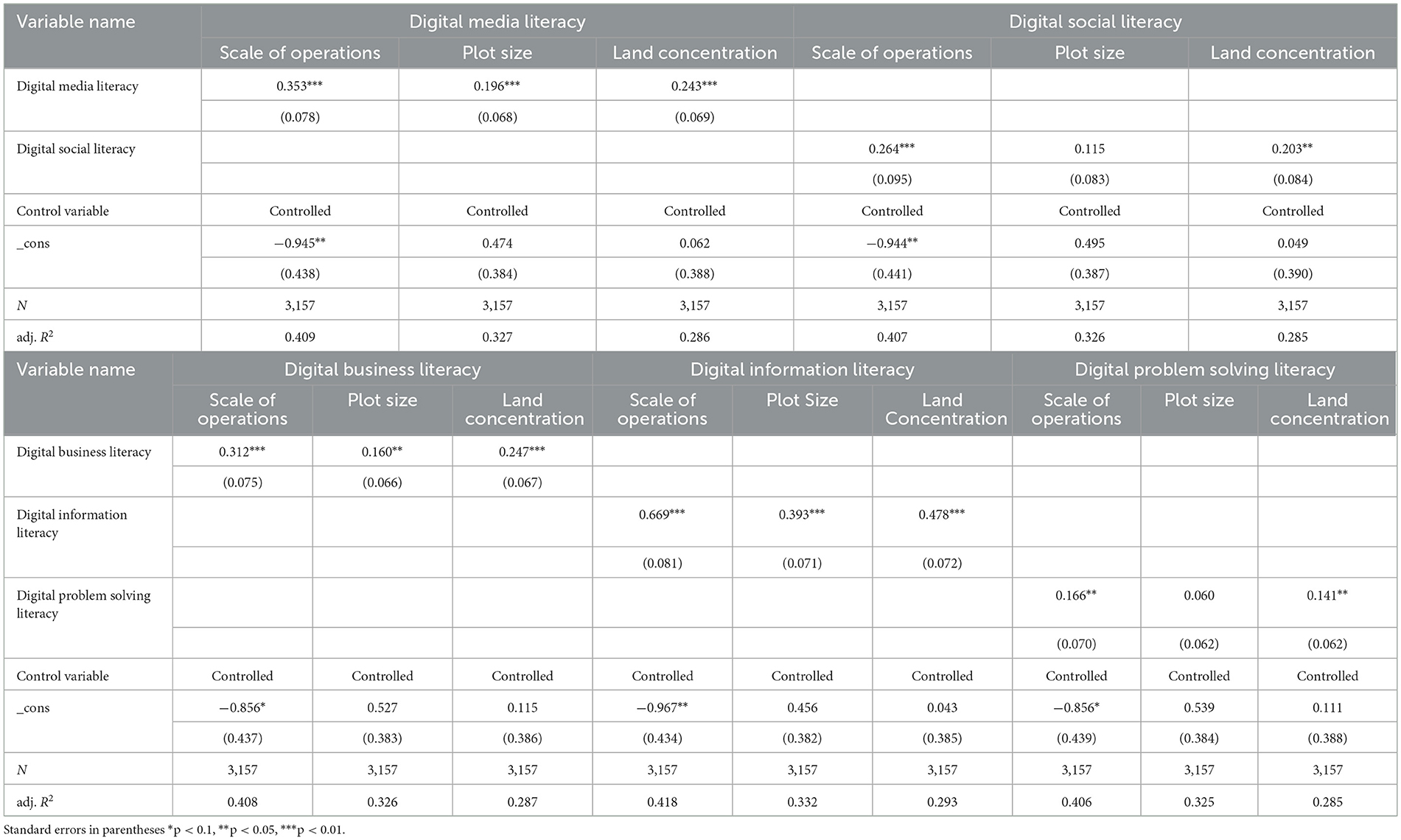
Table 11. Analysis of the effect of different dimensions of digital literacy and farmland scale management.
In conclusion, land income dependence specifically moderates the relationship between digital literacy and the scale of farmland operations, indicating that land dependence, in general, strengthens the positive effect of digital literacy on the scale of these operations. Overall, the research hypothesis, which posits that land dependence can enhance the promotional effect of digital literacy on farmers' farmland scale operations, has been empirically validated.
5 Discussion
This study utilizes data from the 2020 Chinese Academy of Social Sciences rural revitalization research and employs factor analysis and principal component analysis to assess the digital literacy levels of farmers. Building upon a theoretical framework that elucidates the impact of digital literacy on the scale of farmers' agricultural land operations, the study further applies linear regression models, mediation effect models, and other analytical techniques to explore the effects and mechanisms of farmers' digital literacy on the scale of their land operations. The key findings of the study are as follows:
Firstly, our findings indicate that farmers with higher levels of digital literacy are more likely to operate larger farmland scales, manage larger organized land plots, and exhibit higher degrees of land concentration. Thus, our hypothesis holds true: an enhancement in digital literacy levels can spur the expansion of farmland operation scales among farmers. In contexts where the efficacy of national policies is constrained, the ongoing improvement of farmers' digital literacy levels and the stimulation of their intrinsic motivation to enlarge farmland scales may serve as a means to surpass the present bottlenecks hindering the development of agricultural land scale operations in China. Secondly, we have uncovered that an elevation in digital literacy levels stimulates farmland transfer behavior among farmers and prompts them to lease additional farmland, thereby exerting an influence on their farmland operation scales. From the vantage point of land dependence, we have examined the impact of farmers' digital literacy levels on their farmland operation scales and found that farmers with a stronger reliance on land experience a more pronounced impact on their farmland operation scales when their digital literacy levels improve. Consequently, to foster the development of agricultural scale operations, it is imperative to consider refining the farmland transfer market, augmenting the economic returns of agricultural operations for farmers, and bolstering social security. Lastly, our research also reveals disparities in the extent of agricultural operation scales among farmers with varying dimensions of digital literacy and different resource endowments. Therefore, when advancing agricultural scale operations, it is crucial to make informed decisions and tailor measures to specific local conditions.
Moreover, we have undertaken a comparative analysis of our study compared with other research endeavors. Firstly, our research findings exhibit similarities with those of Riyazuddin et al. (2021). Their team, in exploring the correlation between the Indian caste system and agricultural productivity, observed that disadvantaged groups face impediments in accessing agricultural resources, such as land. This aligns with our conclusion that farmers with lower levels of digital literacy tend to possess smaller landholdings. However, a notable distinction lies in Riyazuddin's assertion that disadvantaged groups achieve higher output per unit of land. This phenomenon can be attributed to the tendency of India's socially marginalized groups to cultivate high–value, labor–intensive crops, which yield greater returns. In contrast, the Chinese government places emphasis on food security and has implemented pertinent policies to bolster grain production. Secondly, our research indicates that a higher degree of land concentration and larger scale farming can facilitate the advancement of agricultural modernization. This finding contradicts the research conducted by Lin (2008). Lin discovered that despite the high concentration of land in Pakistan, the anticipated economies of scale in agriculture have not been realized; instead, this has exacerbated farmer poverty and hindered agricultural development. The underlying reason for this discrepancy is that Pakistan's land system is characterized by private ownership, with land concentrated in the hands of a few landlords. Consequently, farmers can only lease land for agricultural production and are unable to engage in effective large–scale agricultural management. Thirdly, our study reveals that digital literacy enhances the likelihood of farmers engaging in land transfer activities, thereby influencing agricultural scale management. This finding is consistent with Osman's research (Osman et al., 2025). Osman, in analyzing the factors driving land use in the Sudan region, found that farmers adjust their land use practices based on market demand and other factors. In our theoretical framework, digital literacy can mitigate market information asymmetry, heighten farmers' expectations for farming, and subsequently encourage them to participate in large–scale agricultural management. This hypothesis has been substantiated through empirical research.
Against the backdrop of the steady advancement of digital rural construction and digital economic development in China, there is a promising prospect for a significant enhancement in farmers' digital literacy levels. When farmers' digital literacy reaches a certain threshold, the agricultural development model will undergo a transformation, gradually shifting from traditional low–value agriculture to modern high–value agriculture. Novel agricultural models such as digital agriculture, precision agriculture, and smart agriculture will emerge as a result. A close, mutually reinforcing, and bidirectionally empowering relationship exists between farmers' digital literacy and modern high–value agriculture, which is manifested in the following four aspects: (1) The improvement of farmers' digital literacy enables them to proficiently utilize digital technologies to comprehensively search for and systematically organize data information related to various stages of agricultural cultivation. Through in–depth calculation and analysis of this data, farmers can formulate scientific production plans that are highly aligned with actual production conditions, thereby achieving precision in agricultural production and enhancing its efficiency and quality. (2) Digital literacy encourages farmers to actively utilize agricultural and rural big data platforms to conduct intelligent perception, early warning, and decision–making analysis on multiple key aspects such as agricultural safety production, agricultural product processing and quality traceability, and rural industrial development. Leveraging the powerful capabilities of big data platforms, farmers can obtain real–time dynamic information on agricultural production, achieve visual management of agricultural production, and promptly identify and resolve issues that arise during the production process. (3) With the data information editing and production capabilities bestowed by digital literacy, farmers can innovatively transform traditional agricultural production models. By tapping into the multifunctionality of agriculture and combining market demands and consumer preferences, they can create innovative new forms of agricultural production, such as agricultural tourism, agricultural experience activities, and customized agricultural products, thereby expanding the value and industrial chains of agriculture. (4) The development of modern high–value agriculture places higher demands on the quality of agricultural labor. To adapt to the development needs of modern high–value agriculture, farmers need to continuously update their knowledge and engage in digital practices, learning new agricultural technologies, management concepts, and digital skills. In this process, farmers' digital literacy levels will be rapidly enhanced, forming a virtuous cycle that further promotes the sustainable development of modern high–value agriculture.
In comparison to existing research, this paper offers several marginal contributions: firstly, regarding the measurement of digital literacy, our study builds upon the Global Digital Literacy Framework issued by UNESCO and integrates the present context of China's agricultural and rural development. We construct a comprehensive digital literacy indicator system encompassing two dimensions: digital access and digital application. This system aims to highlight the digital divide at various levels, consisting of 5 second–level indicators and 17 third–level indicators. This approach not only expands the current understanding of digital literacy and its implications for rural China but also diversifies the existing research methodologies on digital literacy assessment frameworks. Secondly, we introduce an innovative analysis of farmland management scale, considering three dimensions: farmers' operational scale, plot size, and plot mean (average plot size). By separately examining the relationships between “digital literacy – operational scale,” “digital literacy – plot size,” and “digital literacy – plot mean,” we enrich the theoretical literature on agricultural scale management and offer a novel perspective. Thirdly, our study leverages field research data collected from farmers across 10 provinces in China, addressing the inherent limitation of past data sources. This comprehensive dataset allows us to more thoroughly demonstrate how farmers' digital literacy levels impact the scale of agricultural land operations. Furthermore, it scientifically unravels the internal transmission mechanisms of land transfer and land dependence, thereby enhancing the reliability, precision, and external validity of our conclusions.
6 Recommendation
Based on these conclusions, this paper offers the following policy recommendations:
(1) It is imperative to advance the development of rural digital infrastructure in order to improve farmers' access to digital resources. This objective can be accomplished through several strategic initiatives: initially, promoting the deployment of integrated “5G + satellite” internet coverage is essential. As an illustration, Suichang County in Zhejiang Province has successfully implemented precise management of tea plantations utilizing the “5G + Beidou” system, enabling farmers to access real–time data via their mobile devices. Secondly, optimizing the digital service ecosystem is crucial, which may involve strategies such as popularizing intelligent terminals through a combination of government subsidies and corporate concessions, as well as establishing digital service stations within village committees to offer equipment usage guidance and training programs. Thirdly, the establishment of a data property rights trading platform for agricultural products is recommended, allowing farmers to generate income by sharing agricultural operational data, thereby incentivizing the adoption of digital tools. Lastly, the creation of a rural digital infrastructure index is proposed to systematically assess indicators such as network coverage and equipment utilization rates across different regions, addressing existing network deficiencies.
(2) Efforts should be made to improve the factor market system and facilitate the efficient circulation of various factors. Accelerating the construction of the factor market system, refining its rules and regulations, and eliminating barriers to factor mobility can effectively promote land transfer and integration. This, in turn, fosters the scale and mechanization of agricultural operations, maximizes the scale effect of agricultural production, and enhances overall efficiency. Moreover, encouraging the flow of urban capital, technology, and human resources to rural areas can facilitate the effective allocation of high–quality resources in the agricultural sector, further amplifying the impact of digital elements on farmers' agricultural production and operation.
(3) There is a need to enhance support mechanisms for farmers, aiming to bolster their risk resilience. This can be achieved through the following measures: firstly, increasing financial subsidies for the agricultural sector is vital to ensure a stable and reliable supply of agricultural production materials, thereby reducing farmers' production and operational costs. Secondly, innovating agricultural insurance cooperation models and fostering a collaborative ecosystem involving government, enterprises, and farmers is essential. For instance, the “Vegetable e–Loan” project in Shouguang, Shandong Province, allows farmers who have completed e–commerce training to secure loans of up to 500,000 yuan at an interest rate 1.5% points below the market rate by presenting their insurance policies. Concurrently, establishing a “platform + farmer” data–sharing model, where farmers authorize platforms to access pertinent agricultural information, and in return, platforms provide farmers with risk alerts and insurance policy insights through data analysis, can be beneficial. Furthermore, the government should offer corresponding insurance premium subsidies to enhance farmers' capacity to withstand natural and market risks, bolster their confidence in farming, stabilize their farming income, and further amplify the impact of digital literacy on their production and operational activities.
(4) It is crucial to innovate the digital training framework for farmers to stimulate their intrinsic motivation. This can be accomplished through the following strategies: firstly, establishing and refining a tiered training system for farmers' digital literacy, and promoting the development of categorized programs such as the “Silver Hair Classroom” and the “New Farmer Incubation Camp” is necessary. For example, the “Silver Hair Classroom” focuses on equipping elderly farmers with fundamental skills like mobile payments and video calls, while the “New Farmer Incubation Camp” offers returning youth farmers content on e–commerce live streaming and digital operational management. Secondly, leveraging short video platforms like Douyin to create a library of agricultural knowledge videos in local dialects can effectively engage local farmers in learning.
Data availability statement
The raw data supporting the conclusions of this article will be made available by the authors, without undue reservation.
Author contributions
LY: Formal analysis, Methodology, Visualization, Writing – original draft, Writing – review & editing, Conceptualization, Data curation, Funding acquisition, Investigation, Project administration, Resources, Software, Supervision, Validation. SY: Data curation, Formal analysis, Investigation, Software, Validation, Writing – review & editing, Writing – original draft, Visualization, Conceptualization, Funding acquisition, Methodology, Project administration, Resources, Supervision. BL: Conceptualization, Funding acquisition, Project administration, Resources, Writing – original draft, Writing – review & editing, Formal analysis, Supervision, Validation, Data curation, Investigation, Methodology, Software, Visualization.
Funding
The author(s) declare that financial support was received for the research and/or publication of this article. This research was funded by Jiangxi Province Industrial Economic System Industry Integration Post Project (Grant No. JXARS-16) and Jiangxi Provincial Key Research Base Project for Philosophy and Social Sciences (Grant No. 23ZXSKJD14).
Conflict of interest
The authors declare that the research was conducted in the absence of any commercial or financial relationships that could be construed as a potential conflict of interest.
Generative AI statement
The author(s) declare that no Gen AI was used in the creation of this manuscript.
Publisher's note
All claims expressed in this article are solely those of the authors and do not necessarily represent those of their affiliated organizations, or those of the publisher, the editors and the reviewers. Any product that may be evaluated in this article, or claim that may be made by its manufacturer, is not guaranteed or endorsed by the publisher.
Supplementary material
The Supplementary Material for this article can be found online at: https://www.frontiersin.org/articles/10.3389/fsufs.2025.1546024/full#supplementary-material
Footnotes
1. ^People's Daily. ‘Over 98% of administrative villages nationwide have access to fiber optics'. [2019-08-02]. https://www.gov.cn/xinwen/2019-08/02/content_5418058.htm.
References
Adamopoulos, T., Brandt, L., Leight, J., and Restuccia, D. (2022). Misallocation, selection, and productivity: a quantitative analysis with panel data from China. Econometrica 90, 1261–1282. doi: 10.3982/ECTA16598
Bao, G. X., Liu, Q. C., and Guan, B. (2021). Why property rights strength cannot accelerate the transfer of agricultural land—the mediating role of endowment effect and the moderating role of land attachment. J. Lanzhou Univ. 49, 66–79 (In Chinese). doi: 10.13885/j.issn.1000-2804.2021.03.007
Barrett, C. B., Bellemare, M. F., and Hou, J. Y. (2010). Reconsidering conventional explanations of the inverse productivity—size relationship. World Dev. 38, 88–97. doi: 10.1016/j.worlddev.2009.06.002
Carletto, C., Savastano, S., and Zezza, A. (2013). Fact or artifact: the impact of measurement errors on the farm size—productivity relationship. J. Dev. Econ. 103, 254–261. doi: 10.1016/j.jdeveco.2013.03.004
Courtois, P. (2015). Farmer bargaining power and market information services. Am. J. Agric. Econ. 97, 953–977. doi: 10.1093/ajae/aau051
Deininger, K., Jin, S., Liu, Y., and Singh, S. K. (2018). Can labor-market imperfections explain changes in the inverse farm size—productivity relationship? Longitudinal evidence from rural India. Land Econ. 94, 239–258. doi: 10.3368/le.94.2.239
Du, F. J., Zheng, J., and Zhao, X. Y. (2024). From ‘spectatorship' to ‘implementation': the impact of digital literacy on low-carbon production of farm households—the mediating effect based on endowment capacity. Rural Econ. 77–87. (In Chinese)
Du, Z. C., and Xiao, W. D. (2019). Large-scale agricultural management: current situation, problems and policy choices. Jianghuai Tribune 11–19+28. doi: 10.16064/j.cnki.cn34-1003/g0.2019.04.002 (In Chinese)
Haans, R. F. J., Pieters, C., and He, Z. L. (2016). Thinking about U: theorizing and testing U-and inverted U-shaped relationships in strategy research. Strat. Manag. J. 37, 1177–1195. doi: 10.1002/smj.2399
He, Y. Q., Liu, Y. D., Guo, J. Y., and Chen, J. H. (2024). Digital literacy, social network and adoption intensity of organic fertiliser substitution technology among food growers-empirical evidence based on CRRS data. J. Agric. Forestry Econ. Manag. 23, 643–651 (In Chinese). doi: 10.16195/j.cnki.cn36-1328/f.2024.05.67
Hua, J., and Pan, S. T. (2024). Digital literacy divide and income inequality of farming households. J. South China Agric. Univ. 23, 35–47. (In Chinese)
Julien, J. C., Bravo-Ureta, B. E., and Rada, N. E. (2019). Assessing farm performance by size in Malawi, Tanzania, and Uganda. Food Policy 84, 153–164. doi: 10.1016/j.foodpol.2018.03.016
Kawagoe, T. (1999). Agricultural Land Reform in Postwar Japan: Experiences and Issues, Policy Working Paper 2111. Washington, DC: World Bank.
Key, N. (2019). Farm size and productivity growth in the United States Corn Belt. Food Policy. 84, 186–195. doi: 10.1016/j.foodpol.2018.03.017
Kim, S. H., and Kamiya, M. (1992). Farm Size and Structural Reform of Agriculture. I. Korea. II. Japan.
Lamb, R. L. (2003). Inverse productivity: land quality, labor markets, and measurement error. J. Dev. Econ. 71, 71–95. doi: 10.1016/S0304-3878(02)00134-7
Li, C. J., Zhang, B., and Yuan, R. J. (2009). The social security function of rural land and the improvement of rural land system: and the protection of farmers' rights and interests. Rural Econ. 27–29. (In Chinese)
Liang, W. (2022). County governance of land fragmentation: system construction and practical mechanism. J. Northwest Agric. Forestry Univ. 22, 36–45 (In Chinese). doi: 10.13968/j.cnki.1009-9107.2022.02.05
Lin, Y. J. (2008). The impact of land ownership conditions in pakistan on agricultural scale operation. Agric. Outlook. 4, 34–37. (In Chinese)
Liu, B., and Zhou, J. (2023). Digital literacy, farmers' income increase and rural internal income gap. Sustainability 15:11422. doi: 10.3390/su151411422
Liu, G. B., and Zeng, J. X. (2004). Agricultural scale efficiency and implementation problems under rural business system. Seeking 43–45+145 (In Chinese). doi: 10.16059/j.cnki.cn43-1008/c.2004.09.015
Liu, L. H., and Zhang, Y. X. (2022). Influence mechanism of farmers' social class on their land transfer behaviour—based on the mediating effect of farmers' land dependence. Resour. Sci. 44, 2525–2539. (In Chinese). doi: 10.18402/resci.2022.12.11
Liu, T. S., and Kong, X. Z. (2017). Support measures, realisation methods and reform thoughts on agricultural large-scale business - a survey and research based on rural reform pilot zones. Rural Econ. 97–102. (In Chinese)
Liu, Y. B., and Wen, T. (2024). Digital literacy and farm household income gap: exacerbation or alleviation? —Based on micro evidence from the central and western regions. Journal of Northwest Agric. Forestry Univ. 24, 91–101. doi: 10.13968/j.cnki.1009-9107.2024.04.10. (In Chinese)
Lv, J., Xu, X., and Yin, G. Q. (2024). How can farmers' dual-scale operation improve grain income? Arid Zone Resour. Environ. 38, 96–103. doi: 10.13448/j.cnki.jalre.2024.033. (In Chinese)
Martin, A., and Grudziecki, J. (2006). DigEuLit: concepts and tools for digital literacy development. Innov. Teach. Learn. Inf. Comput. Sci. 5, 249–267. doi: 10.11120/ital.2006.05040249
Osman, A. A. M., Rahman, A. M. E., Onono, O. J., Elhag, M. M., Olaka, L. A., and Tonnang, H. E. Z. (2025). Integrating satellite remote sensing data and small-scale farmers' perceptions to determine land use/ land cover changes and their driving factors in Gedaref state, Sudan. Environ. Dev. Sustain. 1–27. doi: 10.1007/s10668-024-05689-w
Pu, L. Z., and Zheng, F. T. (2016). Analysis of initial endowment, land dependence and farmers' land transfer behaviour: an empirical analysis based on a sample of 5165 farmers in 23 provinces. J. Huazhong Univ. Sci. Technol. 30, 42–50. (In Chinese)
Qin, F., Wang, J. C., and Xu, Q. (2022). How does digital economy promote farmers' income? Evidence from rural e-commerce development. Econ. 22, 591–612. (In Chinese)
Rada, N. E., and Fuglie, K. O. (2019). New perspectives on farm size and productivity. Food Policy 84, 147–152. doi: 10.1016/j.foodpol.2018.03.015
Rigg, J., Salamanca, A., and Thompson, E. C. (2016). The puzzle of East and Southeast Asia's persistent smallholder. J. Rural Stud. 43, 118–133. doi: 10.1016/j.jrurstud.2015.11.003
Riyazuddin, M. K., Imdadul, M. H., Zeeshan Noorsaba, K., Isha, K., and Karuna, S. (2021). Caste, land ownership and agricultural productivity in India: evidence from a large-scale survey of farm households. Dev. Pract. 31, 421–431. doi: 10.1080/09614524.2020.1853679
Ruan, R. H., and Luo, M. Z. (2024). Digital literacy, employability and non-farm employment of rural labour. J. Hunan Agric. Univ. 25, 31–39. (In Chinese)
Sheng, Y., Ding, J., and Huang, J. (2019). The relationship between farm size and productivity in agriculture: evidence from maize production in Northern China. Am. J. Agric. Econ. 101, 790–806. doi: 10.1093/ajae/aay104
Sheng, Y., Zhao, S., Nossal, K., and Zhang, D. (2015). Productivity and farm size in Australian agriculture: reinvestigating the returns to scale. Aus. J. Agric. Resour. Econ. 59, 16–38. doi: 10.1111/1467-8489.12063
Shi, H. B., Lu, K. Y., and Luan, J. D. (2019). Land endowment, support policy and the expansion of farm household business scale-Analysis based on the survey data of 1040 farm households in four provinces. J. Northwest Agric. For. Univ. 142–151. (In Chinese)
Sumner, D. A. (2014). American farms keep growing: size, productivity, and policy. J. Econ. Perspect. 28, 147–166. doi: 10.1257/jep.28.1.147
Tang, Y. Q., Jiang, X. H., and Huang, L. Z. (2022). Limited autonomy and rational expansion: an explanatory framework for the ‘difficulty of promoting' concentrated scale farming on agricultural land—a case study based on village a in province S. Chongqing Soc. Sci. 6–22. (In Chinese)
Vollrath, D. (2007). Land distribution and international agricultural productivity. Am. J. Agric. Econ. 89, 202–216. doi: 10.1111/j.1467-8276.2007.00973.x
Wang, H. J. (2024). Digital literacy and farm household income: with a discussion on the formation of digital inequality. China Rural Econ. 86–106. (In Chinese)
Wang, J., Chen, K. Z., Das Gupta, S., and Huang, Z. (2015). Is small still beautiful? A comparative study of rice farm size and productivity in China and India. China Agric. Econ. Rev. 7, 484–509. doi: 10.1108/CAER-01-2015-0005
Wang, J. J., Chen, P. Y., and Chen, F. B. (2012). A comparative study of the business behaviour of farmers with different land sizes and their economic benefits—A case study of the survey data of rice farmers in the Yangtze River Basin. Res. World 34–37. (In Chinese).
Wen, T., and Liu, Y. B. (2023). Digital literacy, financial knowledge and farmers' digital financial behaviour response. Res. Finan. Issues 50–64. (In Chinese)
Wen, Z. L., and Ye, B. J. (2014). Mediation effect analysis: methodology and model development. Adv. Psychol. Sci. 22, 731–745. (In Chinese). doi: 10.3724/SP.J.1042.2014.00731
Williams, D. R., Patterson, M. E., Roggenbuck, J. W., and Watson, A. E. (1992). Beyond the commodity metaphor: examining emotional and symbolic attachment to place. Leis. Sci. 14, 29–46. doi: 10.1080/01490409209513155
Wu, S. C., Qian, Y. H., and Yu, H. L. (2021). Farmers' participation patterns and stability of agricultural scale operations-based on the comparison of land scale operations and service scale operations. Econ. Manag. 30–35. (In Chinese)
Wu, X. L., and Wang, H. (2023). Farmers' digital literacy: framework system, driving effect and cultivation path—an analytical perspective of competence quality theory. E-Government 105–119. (In Chinese)
Xie, A. (2002). Discussion on the problems of land transfer and adequate scale operation in less developed areas of developed provinces. Agric. Econ. Issues 23, 38–41. (In Chinese)
Xu, Z. G. (2023). Development of agricultural scale operation. Agric. Econ. Manag. 13–16. (In Chinese)
Xu, Z. G., Zhang, D., and Cheng, B. D. (2024). The logic of farmland scale operation for food security guarantee in China—An analytical perspective based on dual scale economies of farmers and plots. Manag. World. 40, 106–122. (In Chinese)
Xue, D. Q., Chen, Q., and Lv, Y. Q. (2019). Land dependence and place attachment of rural residents in the Weibei dry loess plateau in the context of land transfer— a comparative study based on landless and non-landless farmers in Huangling County. J. Shaanxi Norm. Univ. 47, 31–39. (In Chinese)
Yang, L. L., Yu, S., Song, C. X., and Ma, H. Y. (2024). Analysis of hotspot evolution and emerging trend of domestic and international agricultural scale operation research based on bibliometric analysis. J. China Agric. Univ. 29, 285–299. (In Chinese)
Yang, Y. Z., and Zhang, X. K. (2024). Study on the impact of digital literacy on smallholder farmers' connection to modern agriculture—Based on a survey of 1,592 smallholder farmers in nine provinces and districts in the Yellow River Basin. Econ. Surv. 41, 42–53. (In Chinese)
Zhang, B., and Li, N. (2022). Research on the impact of digital inclusive finance on the non-farm transfer of rural labour—an empirical analysis based on Mlogit and threshold model. World Agric. 65–75. (In Chinese)
Zhang, B. B., Liu, F. P., Hou, X. B., Zhu, H. D., Niu, W. H., Jin, Y. Y., et al. (2023). Mechanisms of the impact of ‘one household, one field' cultivated land fragmentation management on farmers' income—Empirical evidence based on farmers' data in Yuyang District, Shaanxi Province. China Land Sci. 37, 73–83. (In Chinese)
Zhang, J. N., and Zhang, X. K. (2020). A study on the impact and mechanism of digital literacy on the decision to transfer out of agricultural land: micro evidence from CFPS. China Rural Econ. 57–77. (In Chinese)
Zhang, L. Y., and Wan, J. H. (2023). How the transfer of agricultural land improves the fine-grained operation—an analysis based on the plot size threshold. Rural Econ. 37–47. (In Chinese)
Zhang, Y. Q. (2022). The impact and mechanism of digital financial inclusion on rural land transfer—Empirical evidence from CFPS and PKU-DFIIC. Econ. Manag. 36, 30–40. (In Chinese)
Keywords: digital literacy, farmland scale management, land transfer, land dependence, land
Citation: Yang L, Yu S and Liu B (2025) The impact of digital literacy on farmland scale operations:exploring the mediating and moderation roles of land transfer and land dependence. Front. Sustain. Food Syst. 9:1546024. doi: 10.3389/fsufs.2025.1546024
Received: 16 December 2024; Accepted: 21 April 2025;
Published: 21 May 2025.
Edited by:
Q. Yuan, Chinese Academy of Sciences (CAS), ChinaReviewed by:
Ghulam Raza Sargani, Northwest A&F University, ChinaSiphe Zantsi, Agricultural Research Council of South Africa (ARC–SA), South Africa
Jakub Staniszewski, Poznań University of Economics and Business, Poland
Pankaj Pathak, Symbiosis International University, India
Copyright © 2025 Yang, Yu and Liu. This is an open-access article distributed under the terms of the Creative Commons Attribution License (CC BY). The use, distribution or reproduction in other forums is permitted, provided the original author(s) and the copyright owner(s) are credited and that the original publication in this journal is cited, in accordance with accepted academic practice. No use, distribution or reproduction is permitted which does not comply with these terms.
*Correspondence: Bin Liu, bGl1YmluQGp4YXUuZWR1LmNvbQ==
†These authors have contributed equally to this work
 Lulu Yang
Lulu Yang Song Yu
Song Yu Bin Liu3*
Bin Liu3*